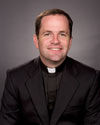Mother's way of honoring the dead
Stations of the Cross, 7 pm, tonight; Eucharistic Adoration to follow. All are welcome!!
Anon wrote the following: “I have a question- why do people visit the gravesites of loved ones? My grandmother’s birthday was the other day and my mom reminded me that I should visit her grave. My immediate thought was, ‘Why- she’s not there anymore?’ I didn’t want to be disrespectful of my mother’s way of honoring her mother’s memory, but I never really understood that tradition. I visit my grandmother in memory. I don’t understand visiting her bones. I didn’t go to the cemetery but instead went to her parish and lit a candle- that seemed more appropriate”.
Anon, your mother’s way of honoring her mother’s memory has been the Church’s way of honoring the dead since the very beginning. In fact, it started with Mary Magdelene visiting the tomb of Christ. The different Gospel accounts reveal specifically why Mary went to visit the gravesite of Christ. She went to “see the tomb” (Mt 28), to “go and anoint him” (Mk 16) with the “spices and perfumed oils…they had prepared” (Lk 23-24), and “stayed outside the tomb weeping” (Jn 20). In general, they reveal Mary’s “sensitivity and affection” (Navarre Bible) for the burial place and dead body of her Lord.
Jesus’ tomb was a sacred place for Mary Magdelene and for the others who visited it. Now, we probably easily understand why the gravesite of our Lord was sacred. It contained the deceased body that had been sacrificed for the salvation of the world. Also, it was the resting place of a Sacred Person! These two truths are unique to Christ. But, Christian gravesites are sacred places as well mainly because they contain the remains of those who shared in Christ’s death and resurrection. As is stated below, “there is a direct relationship between Jesus’ death and resurrection and the death and resurrection of the Christian”.
Also, please keep in mind the following: “the bodies of the dead must be treated with respect and charity, in faith and hope of the Resurrection. The burial of the dead is a corporal work of mercy; it honors the children of God, who are temples of the Holy Spirit” (Catechism, #2300). I would suggest that visiting a gravesite is, by extension, a corporal work of mercy because it is an extension of burying the dead. It definitely is an opportunity to gain an indulgence for the deceased person. The list of indulgences that I’ve linked here before includes a plenary indulgence for “a Visit to a Cemetery. Only applicable to the souls in Purgatory when one devoutly visits and prays for the departed. A PLENARY INDULGENCE is bestowed for this work each day between November 1 and November 8”. It would be a partial indulgence for other days.
Finally, the following are two sites from different dioceses that include information and insights that might also be helpful in understanding why we visit gravesites:
“As people of faith, our burial places share an important meaning for us, since they are sacred places. Each visit to the cemetery is a reminder to us of the love, fellowship and faith that we shared with our deceased family members and friends. It is also a reminder to us of our own mortality and belief in the Resurrection.
Just as we are brought to a sacred place, the Catholic Church, at the time of our birth to be baptized and enter into the life of Christ, so too are we brought to another sacred place, a Catholic cemetery, at the time of our death to await the resurrection of the dead and the promise of eternal life that comes to us through life in Christ”
http://www.madisondiocese.org/diocesancemeteries/FrequentQuestions/tabid/1176/Default.aspx
“Catholic Cemeteries are an extension of the parish where those who have worshipped and prayed together in life now await the resurrection of the body in death.
Catholic Cemeteries are rooted in ancient religious traditions that display a respect for the deceased and a reverence for their physical remains.
A core belief which dates back to the birth of Christianity is that there is a direct relationship between Jesus’ death and resurrection and the death and resurrection of the Christian. Catholics believe in life eternal. Jesus said: “I am the resurrection and the life; whoever believes in me will never die.” (Jn.11:25-26). Just as Christ rose from the dead, He will raise our mortal remains to be like His in glory.
Catholic cemeteries are a constant reminder that death is just a part of the journey that leads to new life.
Catholic cemeteries are sacred places that strive to create a religious environment conducive of prayer, reflection and remembrance. Our cemeteries encourage prayerful visitation through the use of statuary, landscaping, architecture and Christian symbolism throughout buildings and by memorialization.”
-http://www.holyroodcemetery.org/faq.htm

